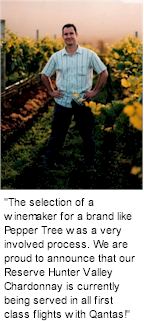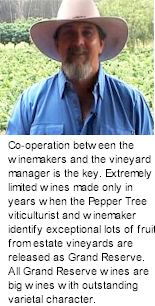


Over the years Pepper Tree have acquired vineyards in the Orange, Wrattonbully and Coonawarra growing areas to enable the winemaker production of varietal wines that either did not grow as well in the Hunter Valley, or are different expressions of a particular varietal that are of interest to connoisseurs of fine wines. The character and complexity reflected in the Appellation wines are an expression of diverse vineyard resources. A second is the balance and elegance in the Multi-Regional range of varietals. These are blends of a varietal wine made from grapes grown at two or more of vineyards that vary from year to year. All Pepper Tree wines are produced, aged and bottled at the winery.

The Hunter Valley is one of Australia's best white wine areas and consistently wins a disproportionate number of awards in National Wine Shows. Pepper Tree's Hunter Valley vineyard is in the Mount View area of the Lower Hunter Valley in the sheltered foothills of the Brokenback Range and covers 38.5 ha of plantings made up of 16.5 ha Chardonnay, 2.5 ha Verdelho, 3.7 ha Semillon, 7.5 ha Shiraz, 1 ha Viognier, 1 ha Sauvignon blanc, 3 ha Merlot, 2.4 ha Cabernet, 0.5 ha Grenache and 0.5 ha Pinot Noir.
The Mount View area produces highly distinctive Chardonnay with flavours of melon, passionfruit and pineapple. Verdelho also performs well in the area with soft tropical fruit characters balanced by good natural acidity. Semillon has the usual lime-citrus characters with flavours being at the higher end for the variety. Shiraz from the area is typically soft, spicy and elegant with a perfumed bouquet.
The Orange region of New South Wales is one of Australia's newest premium regions being favoured for its high altitude cool climate. Situated approximately 270 km west of Sydney the topography and soils of the Orange region are dominated by the extinct volcano Mt Canobolas. Pepper Tree's Orange vineyard sits in a small subvalley protected on 3 sides with a sunny northerly aspect. Elevations vary from 740m to 800m and the site is capable of ripening all the main red varieties as well as Chardonnay and Sauvignon Blanc. Cabernet, Merlot & Shiraz all produce wines with deep red colours and intense palate complexity.

The wines from Pepper Tree's Orange vineyard typically have a lighter more elegant structure than those of warmer areas with light lifted fruit acids lengthening the palate. In addition to the main red varieties, small blocks of Pinot Noir (for sparkling base) & Zinfandel have been planted. Zinfandel produces rich spice and berry characters with crimson red colours. This variety seems well suited to the Orange region and the wines show great promise.
Coonawarra is Australia's top red wine area specialising in Cabernet Sauvignon of great complexity and elegance. Pepper Tree's Coonawarra vineyard comprises 8 ha of Cabernet and 4 ha of Merlot and is located midway between the town of Penola & Coonawarra. Soils consist of thin dark brown to dark grey clays interspersed with broken limestone fragments. The shallow soils restrict vigour and this, coupled with rigorous canopy management, allows the vignerons to control berry size and bunch numbers and thus eventual crop load. This control of crop level and berry size gives the winemakers the best possible starting material with which to create premium red wines.
Pepper Tree's Wrattonbully vineyard covers 100ha of plantings, mainly Cabernet (48 ha) Merlot (23 ha) and Shiraz (20 ha). Cabernet is planted on the highest dune areas where Terra Rossa soils overlie shallow limestone. Individual blocks are given separate canopy management, cropping structure and moisture control according to soil depth which can vary from a few centimetres to over 1 metre.
Flavour maps constructed for the vineyard have shown considerable variability for both Cabernet and Shiraz, and have allowed the winemakers to isolate individual sections of the vineyard to produce parcels of outstanding quality. Merlot is planted on heavier clay soils at the toe of the main dune as heavy clays have proved best for Merlot in its traditional homeland.
